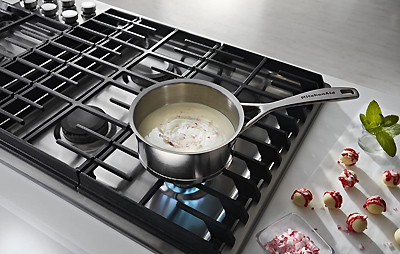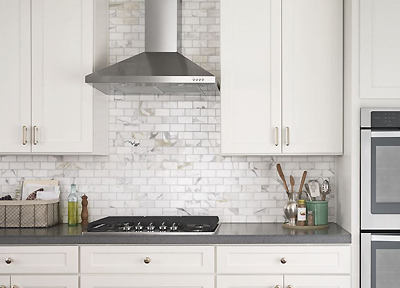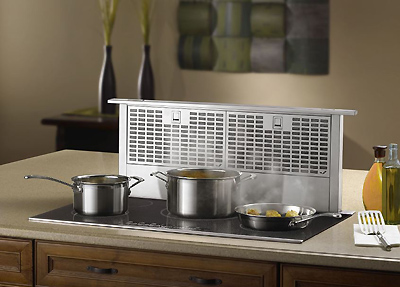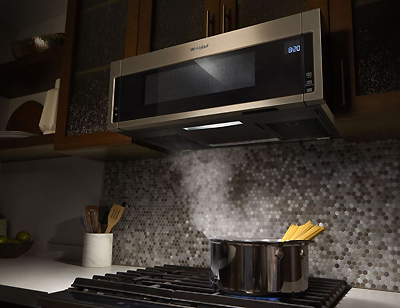Choosing the Best Range Hood for Your Kitchen
by Rachel Lyon, Editorial Director for The House Designers®
Most homeowners get excited about new appliances, whether they’re drawn in by the latest in storage, cooking, or cleanup technology. But if there’s one piece overlooked in the excitement, it’s usually the ventilation hood. While this might not be the most glamorous part of the suite—a matter of opinion, of course—the range hood performs an important function by removing steam, airborne smoke and grease particles, and cooking odors before they can settle into surfaces. It protects your kitchen and the whole house by drawing pollutants out! Range hoods come in all sorts of shapes and sizes, with a variety of different functions, so here’s what you should keep in mind as you shop.
Venting Capacity
First, you should always get a hood at least as wide as your range to make sure it has an effective capture area. Then, consider the cubic feet per minute (CFM) ventilation rating. The higher the number, the faster the range hood will vent. You should have a good idea of what you’re looking for early on, because it can affect the hood styles available to you, and you may or may not need to account for ducting during construction or renovation. The venting power you need is related to the heat produced by your range/cooktop, the size of the cooking surface, its location (on a wall or island), and the size of the kitchen.
Take, for instance, a standard 30-inch range; placed on a wall, experts recommend a minimum of 250 CFM (100 CFM per linear foot), but over an island, you’d need 375 CFM (150 CFM per linear foot), because it takes more to effectively vent open space. You can also rely on a BTU/hour calculation (BTU/hour divided by 100 for gas; for electric, first multiply watts by 3.412 to determine BTU/hour), which is especially appropriate if you have a high-powered range. In general, your range hood should be able to cycle the air in your kitchen (determined by cubic footage) 15 times per hour, but you should always use the highest CFM produced by these equations as the minimum to keep in mind as you shop.
Ducted vs. Recirculating
Ventilation hoods can vent out of the house, or recirculate the air after passing it through a filter to capture pollutants. Most models are one or the other, but some are convertible with an extra kit, so make sure to know what you need before shopping. In the past, vented hoods spectacularly outperformed recirculating ones, but today’s technology has closed much of the power gap; you’ll find recirculating hoods with more than enough CFM for most kitchens, but you’ll need to vent out for commercial-level power.
Models that recirculate can be placed anywhere, but those that vent out must have ductwork installed. Most ducts send exhaust out horizontally (through a wall) or vertically (through the ceiling), so consider the placement of your cooktop and its relation to an exterior outlet. While your builder can install ductwork that turns in the wall, straight ducts vent more efficiently, so try to keep it simple!
Wall vs. Island Installation
Are you concerned with sightlines? If your range is located against a wall, you can do anything—a wall-mounted, undercabinet, hidden insert, etc., hood—and nobody would question it, but if it’s located on an island, you have to decide if you want to keep your overhead space clear or if you want to add a ceiling-mounted hood. Consider the layout of your kitchen—homeowners who have open floor plans that visually connect to living spaces usually want to keep the view clear, but those with more closed-off or eat-in, country-style kitchens often gravitate toward canopy hoods that add definition.
If you want to keep everything open, you might prefer downdraft ventilation, which uses powerful suction to pull air back down into the cooktop. Within this category, you’ll also find models that extend up from the countertop to remove pollutants and then disappear when you’re finished cooking. This isn’t your typical range hood, but it does the job, and you can find a range of CFM ratings and ducted and recirculating options, too.
Combined Functions
If you have a small kitchen where space is at a premium, you’d probably do anything to preserve what countertop and cabinet space you have. Simple under-cabinet hoods don’t take up much room, come in ducted and recirculating models to suit your needs, and can include some nice light and heat lamp functions that you might expect in large canopies, too. Over-the-range microwaves are popular because they pack two appliances into one, and they have been getting more powerful venting capabilities over the years to put them on-par with larger hoods. They’ve even gotten sleeker and more stylish!
Be sure to bring up your range hood preferences early on! Depending on your decision, your builder might suggest a different kitchen layout to maximize efficiency, and it could also change the plan for cabinetry. Nobody wants to deal with costly modifications during construction, so communicate, get on the same page, and work toward your goal kitchen together.



.png)
.png)





